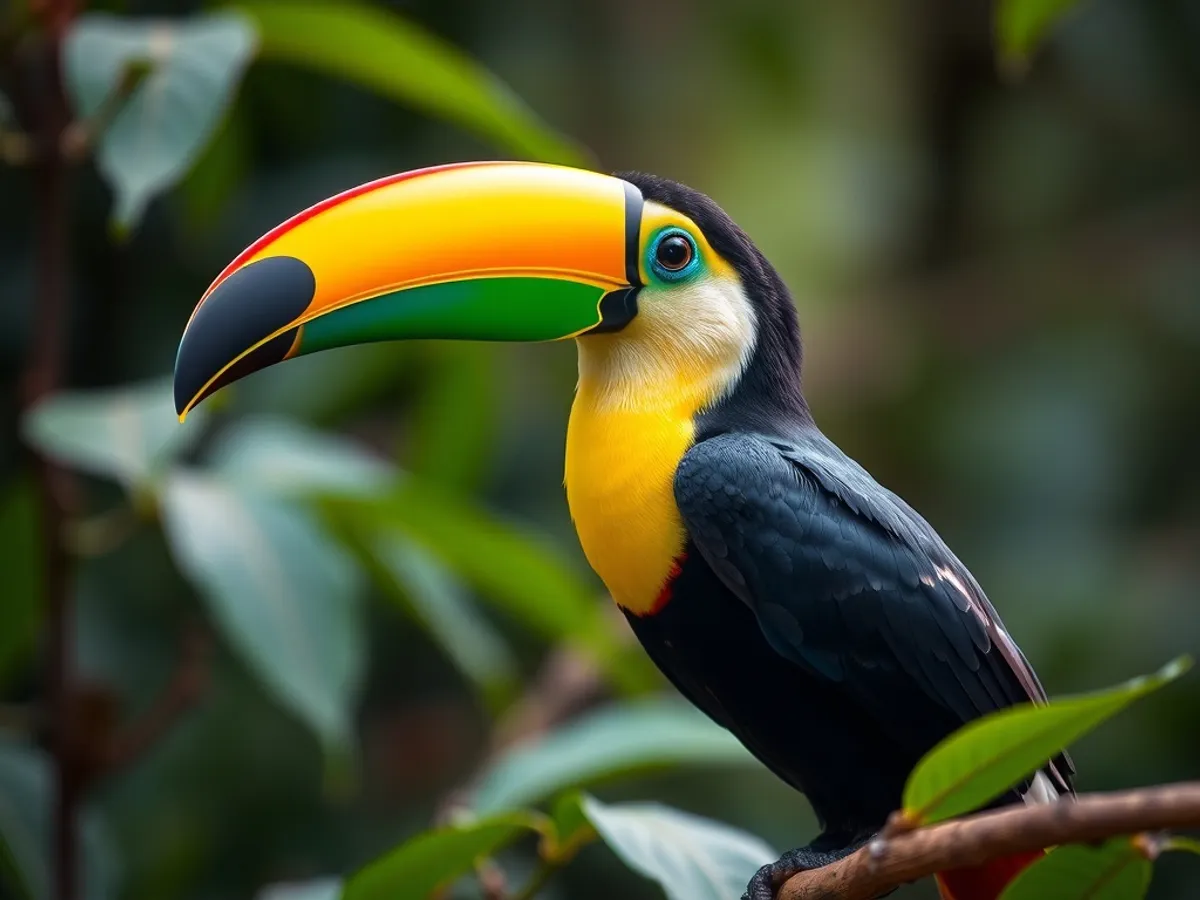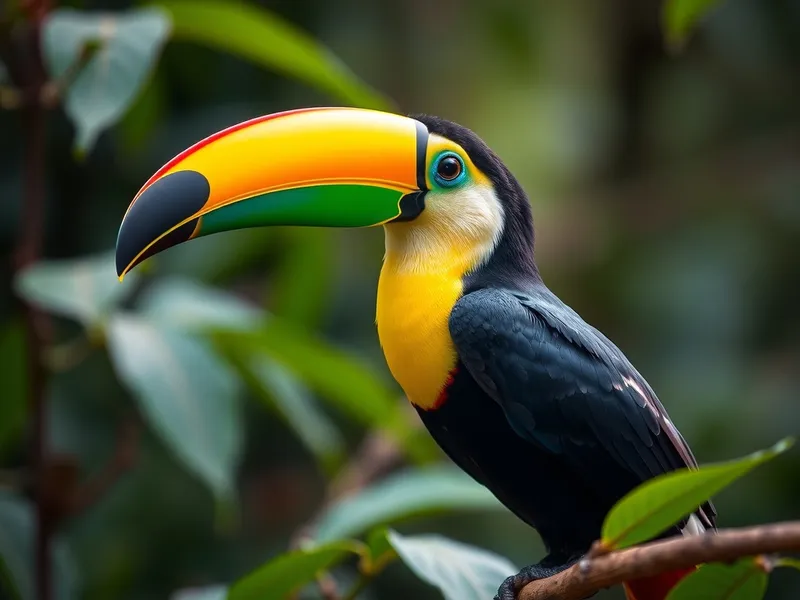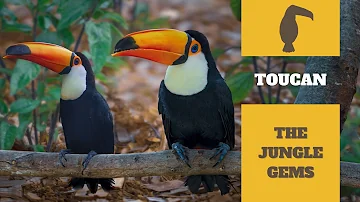
Toco Toucan
Ramphastos toco

Meet the Toco Toucan
The Toco Toucan is the largest and most recognizable toucan species, easily identified by its massive, vibrant orange bill and striking black-and-white plumage. Native to South America, it inhabits tropical and subtropical forests, savannas, and open woodlands, often near riverbanks. Despite its huge bill, the Toco Toucan is agile in the trees, using its bill to reach fruit on branches too small to support its weight. Social and noisy, these birds are frequently observed in pairs or small groups and communicate with loud, croaking calls.
Classification
Bird
Habitat
Tropical and subtropical forests, savannas, and open woodlands
Diet
Omnivore
Lifespan
18-26 years
Conservation
Least Concern
Weight
500–860 grams
📖Fascinating Facts
Giant Beak
The Toco Toucan's beak can be up to 19 cm long, accounting for about one-third of its total body length.
Seed Spreaders
Toco Toucans play a crucial ecological role by dispersing seeds throughout their habitat, promoting forest regeneration.
Colorful Appearance
Their vivid coloration and strikingly large bills make them popular symbols in art, advertising, and pop culture.
📋Detailed Description
The Toco Toucan (Ramphastos toco) is the largest member of the toucan family, reaching a total length of 55–65 cm (21.5–25.5 in) and weighing between 500–860 grams (1.1–1.9 lbs). Its most striking feature is its enormous bill, which can be up to 19 cm (7.5 in) long and accounts for nearly one-third of its total body length. The bill is lightweight, composed of a bony foam structure covered with keratin, and is brightly colored in orange-yellow with a black base and tip. The plumage is predominantly black, with a stark white throat, chest, and uppertail-coverts, and vivid red undertail-coverts. The skin around the eyes is a distinctive blue, accentuating its expressive appearance. Toco Toucans possess zygodactyl feet (two toes facing forward, two backward), which provide a strong grip for climbing and perching. Their wings are relatively short and rounded, making them agile in dense foliage but less suited for long-distance flight. They are highly vocal, producing a variety of croaking, grunting, and rattling calls. Social by nature, Toco Toucans are often observed in pairs or small groups, engaging in mutual preening and bill fencing. Their diet is omnivorous, consisting mainly of fruit, but also includes insects, small reptiles, eggs, and nestlings. Toco Toucans play a crucial ecological role as seed dispersers in their habitats, contributing to forest regeneration.
💡 Did you know?
Toco Toucans regulate their body temperature by adjusting blood flow to their enormous bills, making their beaks serve as natural thermal radiators.
🔬Research & Sources
Wikipedia Summary
The toco toucan is a species of bird in the toucan family Ramphastidae. It is the largest species of toucan and has a distinctive appearance, with a black body, a white throat, chest and uppertail-coverts, and red undertail-coverts. Its most conspicuous feature is its massive beak, which is yellow-orange with a black base and large spot on the tip. It is endemic to South America, where it has a wide distribution from the Guianas south to northern Argentina and Uruguay, and its range has recently been expanding southwards. Unlike other toucans, which inhabit continuous forests, toco toucans inhabit a variety of semi-open habitats at altitudes of up to 1,750 m. They are especially common in the Brazilian cerrado, gallery forests, and the wetlands of the Pantanal.
Last Modified: 5/23/2025
🎭Behavior & Social Structure
Toco Toucans are diurnal and spend much of their day foraging in the canopy and subcanopy layers of semi-open habitats, such as gallery forests, savannas, and the edges of woodlands. They exhibit a highly opportunistic feeding behavior, using their long, dexterous bills to pluck fruit from branches that are otherwise inaccessible. The bill is also used to manipulate, peel, and toss food items into their mouths. In addition to fruit, they actively hunt for insects, small vertebrates, and raid nests for eggs and chicks, especially during the breeding season when protein requirements increase. Socially, Toco Toucans form loose flocks of up to six individuals outside the breeding season, maintaining contact through loud, repetitive calls. They are known for their playful interactions, including bill fencing and mutual preening, which reinforce social bonds. At night, they roost in tree cavities or dense foliage, often huddling together for warmth and protection.
👶Reproduction & Life Cycle
Toco Toucans are monogamous, forming long-term pair bonds. The breeding season varies geographically but generally coincides with the local rainy season (September to February in much of their range). Courtship involves mutual feeding, bill fencing, and vocal displays. Nests are typically located in natural tree cavities or abandoned woodpecker holes, as Toco Toucans lack the ability to excavate their own. The female lays 2–4 white eggs, which are incubated by both parents for about 16–18 days. Both parents participate in feeding and brooding the chicks, which are altricial at hatching—blind, naked, and helpless. The nestlings remain in the cavity for 6–8 weeks, during which time they are fed regurgitated fruit and animal matter. Fledglings are dependent on parental care for several weeks after leaving the nest.
🛡️Adaptations & Survival
The Toco Toucan's bill, though large, is remarkably light due to its honeycomb-like internal structure, allowing for precise manipulation of food and effective thermoregulation. Recent studies have shown that the bill acts as a heat exchange organ, enabling the bird to regulate its body temperature by adjusting blood flow to the bill. Their zygodactyl feet provide excellent grip for climbing and perching on branches. The tongue is long and feather-like, aiding in the manipulation and swallowing of food. Their keen eyesight and color vision are crucial for locating ripe fruit and detecting predators. Social behaviors such as group roosting and mutual preening enhance survival by reducing predation risk and reinforcing social cohesion.
🎨Cultural Significance
The Toco Toucan is an iconic symbol of South American wildlife and is widely recognized in popular culture, advertising, and ecotourism. In indigenous folklore, toucans are often regarded as spiritual messengers or symbols of communication and vitality. The bird has featured prominently in art, literature, and as a national emblem in several South American countries. Its image is also used commercially, most famously as the mascot for a global breakfast cereal brand. While not traditionally hunted for food, its feathers and bill have been used in ceremonial ornaments by some indigenous groups.
🔬Recent Research & Discoveries
Recent research has focused on the Toco Toucan's thermoregulatory adaptations, particularly the role of the bill in dissipating excess body heat (Tattersall et al., 2009). Studies have also examined their role as seed dispersers and their impact on forest regeneration dynamics. Ongoing genetic research is exploring population structure and gene flow across their expanding range, especially in response to habitat fragmentation. Behavioral studies continue to document their complex social interactions, vocalizations, and cognitive abilities, revealing advanced problem-solving skills and adaptability to human-altered landscapes.
🎥Wildlife Videos

Jewel of the Jungle: The Keel Billed Toucan in 4K Close-ups. #birds #4kvideo #documentary
Welcome to 'Jewel of the Jungle: The Keel Billed Toucan in 4K Documentary'. Dive into the dense green rainforests with us as we ...
Pristine Planet 4K

Toco Toucan Description, Characteristics and Facts!
Hi, this is animal planet tv channel. my channale name animal planet tv . Animal videos and documentaries are offered on my ...
animal planet tv

S4 E3: The Toco Toucan Unveiled 🌴🦜
"Join Blaze Wildlife as we uncover the vibrant world of Toco Toucans, the iconic birds of the tropical rainforests! Discover how ...
Blaze Wildlife

Toucan: The JUNGLE Gems | Meet The Wild
Welcome to *Meet the Wild!* In this episode, we explore the fascinating world of the Toucan, known scientifically as *Ramphastos ...
Meet The Wild

All About Toucans
Amazing Toucans! Toucans are birds that live in tropical rainforests. They are well-known for their large and colorful bills.
Next Generation Science

TOCO TOUCAN: The most beautiful birds in the world | 4K video | Animal Documentary
Welcome to Animal Documentary, your ultimate destination for captivating animal documentaries and breathtaking wildlife ...
The Jurassic AI Animation
🌍Habitat Information
The Toco Toucan typically inhabits Tropical and subtropical forests, savannas, and open woodlands environments. Toco Toucans have adapted to their environments with specialized features and behaviors.
Primary Habitat:
Tropical and subtropical forests, savannas, and open woodlands
More detailed habitat information will be available soon.
🛡️Conservation Status
The Toco Toucan is currently classified as Least Concern. Conservation efforts are crucial for preserving this species for future generations.
Common Threats:
- 🏠Habitat loss and fragmentation
- 🌡️Climate change impacts
- 🎯Hunting and poaching
- 🏭Human-wildlife conflict
⚠️Threats & Conservation Challenges
Although currently listed as Least Concern by the IUCN, Toco Toucan populations face localized threats from habitat loss due to agricultural expansion, deforestation, and urbanization, particularly in the Brazilian cerrado and Atlantic Forest regions. They are sometimes hunted for their striking bills, which are sold as curios, and occasionally captured for the illegal pet trade. However, their adaptability to fragmented and semi-open habitats has allowed populations to persist and even expand in some areas. Climate change and ongoing habitat alteration remain long-term concerns for the species' future viability.
🔬Scientific Classification
Scientific Name
Ramphastos toco
Classification Hierarchy
🔍 About Taxonomic Classification
Taxonomic classification is a hierarchical system used by scientists to classify and organize living organisms based on shared characteristics and evolutionary relationships.
The system moves from broad categories (Kingdom) to increasingly specific ones, with each animal's scientific name typically consisting of its Genus and species.
📝Community Notes
Share your observations and insights about the Toco Toucan with our community of wildlife enthusiasts.
Join Our Community
Sign in to share your observations and connect with fellow wildlife enthusiasts.
Sign In to ContributeNo community notes yet
Be the first to share your observations about the Toco Toucan!
Explore Toco Toucan
Select a tab above to learn more about this amazing animal.
📸Photo Gallery
No photos available for this animal yet.
🌟Discover More Wildlife
Continue your journey of discovery with more fascinating animals from our database
